Optimization of a Gas Chromatography–Mass Spectrometry (GCMS) Method for Detecting 28 Allergens in Various Personal Care Products
Abstract
1. Introduction
2. Experimental Section
2.1. Reagents and Materials
2.2. GCMS Analysis
2.3. Stock and Working Standard Solutions
2.4. Sample Preparation
2.4.1. Sample Extraction
2.4.2. Perfumes, Aftershave, and Deodorant Sprays
2.4.3. Shampoos, Creams, Lotions, and Solid Deodorants
2.4.4. Wet Wipes
2.4.5. Solid Lip Care Products
3. Validation Study
3.1. Selectivity Assessments
3.2. Linearity Assessment
3.3. Detection and Quantification Limit
3.4. Examination of Q Values
3.5. Matrix Effect Study
3.6. Uncertainty Assessments
4. Results and Discussion
4.1. Optimization of Chromatographic Conditions
4.2. Selection of the Extraction Solvent
4.3. Effect of Extraction Time and Heat
4.4. Validation of the Method
4.5. Evaluation of Matrix Effect and Expanded Uncertainty
4.6. Cosmetic Real Sample Analysis
5. Conclusions
Author Contributions
Funding
Institutional Review Board Statement
Informed Consent Statement
Data Availability Statement
Conflicts of Interest
References
- Mahajan, V.K. Perfumes and associated allergens: A brief review. Cosmoderma 2022, 2, 21. [Google Scholar] [CrossRef]
- Chou, M.; Mikhaylov, D.; Strugar, T.L. Common allergens present in personal care products: Identification, diagnosis, and management. Semin. Cutan. Med. Surg. 2018, 37, 254–262. [Google Scholar] [CrossRef] [PubMed]
- De Groot, A.C. Fragrances: Contact Allergy and Other Adverse Effects. Dermatitis 2020, 31, 13–35. [Google Scholar] [CrossRef] [PubMed]
- Steinemann, A. Fragranced consumer products: Effects on asthmatics. Air Qual. Atmos. Health 2018, 11, 3–9. [Google Scholar] [CrossRef]
- Regulation (EC) No 1223/2009 of the European Parliament and of the Council—EUR-Lex. Available online: https://eur-lex.europa.eu/legal-content/en/LSU/?uri=CELEX:32009R1223 (accessed on 17 December 2022).
- GSO 1943:2021; Cosmetic Products–Safety Requirements of Cosmetics and Personal Care Products. GCC Standardization Organization: Riyadh, Saudi Arabia, 2021. Available online: https://www.gso.org.sa/store/standards/GSO:781231/GSO%201943:2021?lang=en (accessed on 1 July 2021).
- Api, A.M.; Belsito, D.; Biserta, S.; Botelho, D.; Bruze, M.; Burton, G.A., Jr.; Buschmann, J.; Cancellieri, M.A.; Dagli, M.L.; Date, M.; et al. RIFM fragrance ingredient safety assessment, benzaldehyde, CAS Registry Number 100-52-7. Food Chem. Toxicol. 2019, 134, 110878. [Google Scholar] [CrossRef]
- Gad, S.C.; Pham, T. Safrole. In Encyclopedia of Toxicology, 3rd ed.; Wexler, P., Ed.; Academic Press: Cambridge, MA, USA, 2014; pp. 205–207. [Google Scholar] [CrossRef]
- Api, A.M.; Belsito, D.; Botelho, D.; Bruze, M.; Burton, G.A., Jr.; Buschmann, J.; Cancellieri, M.A.; Dagli, M.L.; Date, M.; Dekant, W.; et al. RIFM fragrance ingredient safety assessment, eucalyptol, CAS Registry Number 470-82-6. Food Chem. Toxicol. 2022, 159, 112720. [Google Scholar] [CrossRef]
- Famiglini, G.; Termopoli, V.; Palma, P.; Capriotti, F.; Cappiello, A. Rapid LC-MS method for the detection of common fragrances in personal care products without sample preparation. Electrophoresis 2014, 35, 1339–1345. [Google Scholar] [CrossRef]
- The International Fragrance Association Analytical Working Group. Analytical Method to Quantify 57 Suspected Allergens (and Isomers) in Ready to Inject Fragrance Materials by Gas Chromatography and Mass Spectrometry. Available online: https://ifrafragrance.org/docs/default-source/guidelines/23754_gd_2017_04_11_ifra_analytical_method_to_quantify_57_suspected_allergens_(and_isomers)_in_ready_to_inject_fragrance_materials_by_gc-ms-(3).pdf?sfvrsn=ad55ac1_6 (accessed on 15 November 2016).
- Belhassen, E.; Bressanello, D.; Merle, P.; Raynaud, E.; Bicchi, C.; Chaintreau, A.; Cordero, C. Routine quantification of 54 allergens in fragrances using comprehensive two-dimensional gas chromatography-quadrupole mass spectrometry with dual parallel secondary columns. Part I: Method development. Flavour Fragr. J. 2018, 33, 63–74. [Google Scholar] [CrossRef]
- Celeiro, M.; Garcia-Jares, C.; Llompart, M.; Lores, M. Recent Advances in Sample Preparation for Cosmetics and Personal Care Products Analysis. Molecules 2021, 26, 4900. [Google Scholar] [CrossRef]
- Sánchez-Prado, L.; Llompart, M.; Lamas, J.P.; Garcia-Jares, C.; Lores, M. Multicomponent analytical methodology to control phthalates, synthetic musks, fragrance allergens and preservatives in perfumes. Talanta 2011, 85, 370–379. [Google Scholar] [CrossRef]
- Pérez-Outeiral, J.; Millán, E.; Garcia-Arrona, R. Ultrasound-assisted emulsification microextraction coupled with high-performance liquid chromatography for the simultaneous determination of fragrance allergens in cosmetics and water. J. Sep. Sci. 2015, 38, 1561–1569. [Google Scholar] [CrossRef]
- Lamas, J.P.; Sanchez-Prado, L.; Garcia-Jares, C.; Lores, M.; Llompart, M. Development of a solid phase dispersion-pressurized liquid extraction method for the analysis of suspected fragrance allergens in leave-on cosmetics. J. Chromatogr. A 2010, 1217, 8087–8094. [Google Scholar] [CrossRef]
- Capuzzo, A.; Maffei, M.E.; Occhipinti, A. Supercritical Fluid Extraction of Plant Flavors and Fragrances. Molecules 2013, 18, 7194–7238. [Google Scholar] [CrossRef]
- Hou, X.; Wang, L.; Tang, X.; Xiong, C.; Guo, Y.; Liu, X. Application of a β-cyclodextrin/graphene oxide-modified fiber for solid-phase microextraction of six fragrance allergens in personal products. Analyst 2015, 140, 6727–6735. [Google Scholar] [CrossRef]
- Lu, C.H.; Fang, M.C.; Chen, Y.Z.; Huang, S.C.; Wang, D.Y. Quantitative analysis of fragrance allergens in various matrixes of cosmetics by liquideliquid extraction and GCeMS. J. Food Drug Anal. 2021, 29, 700–708. [Google Scholar] [CrossRef]
- Desmedt, B.; Canfyn, M.; Pype, M.; Baudewyns, S.; Hanot, V.; Courselle, P.; De Beer, J.O.; Rogiers, V.; De Paepe, K.; Deconinck, E. HS–GC–MS method for the analysis of fragrance allergens in complex cosmetic matrices. Talanta 2015, 131, 444–451. [Google Scholar] [CrossRef]
- Gimeno, P.; Maggio, A.F.; Bousquet, C.; Quoirez, A.; Civade, C.; Bonnet, P.A. Analytical method for the identification and assay of 12 phthalates in cosmetic products: Application of the ISO 12787 international standard “Cosmetics–Analytical methods–Validation criteria for analytical results using chromatographic techniques”. J. Chromatogr. A 2012, 1253, 144–153. [Google Scholar] [CrossRef]
- Lores, M.; Celeiro, M.; Rubio, L.; Llompart, M.; Garcia-Jares, C. Extreme cosmetics and borderline products: An analytical-based survey of European regulation compliance. Anal. Bioanal. Chem. 2018, 410, 7085–7102. [Google Scholar] [CrossRef]
- EN 16274:2012; Methods for Analysis of Allergens—Quantification of Suspected Fragrance Allergens. European Committee for Standardization: Brussels, Belgium, 2012. Available online: https://standards.iteh.ai/catalog/standards/cen/83fc0d7f-746a-46e9-8019-c8a703a3fcd2/en-16274-2012 (accessed on 31 December 2012).
- Begnaud, F.; Chaintreau, A. Good quantification practices of flavours and fragrances by mass spectrometry. Philos. Trans. R. Soc. A Math. Phys. Eng. Sci. 2016, 374, 20150365. [Google Scholar] [CrossRef]
- Rastogi, S.C.; Johansen, J.D.; Menné, T.; Frosch, P.; Bruze, M.; Andersen, K.E.; Lepoittevin, J.P.; Wakelin, S.; White, I.R. Contents of fragrance allergens in children’s cosmetics and cosmetic-toys. Contact Dermat. 1999, 41, 84–88. [Google Scholar] [CrossRef]
- Lamas, J.P.; Sanchez-Prado, L.; Garcia-Jares, C.; Llompart, M. Determination of fragrance allergens in indoor air by active sampling followed by ultrasound-assisted solvent extraction and gas chromatography–mass spectrometry. J. Chromatogr. A 2010, 1217, 1882–1890. [Google Scholar] [CrossRef] [PubMed]
- Heo, J.; Kim, U.; Oh, J.-E. Simultaneous quantitative analysis of four isothiazolinones and 3-iodo-2-propynyl butyl carbamate present in hygienic consumer products. Environ. Eng. Res. 2019, 24, 137–143. [Google Scholar] [CrossRef]
- Rocha, B.; Bocato, M.; Latorraca, E.; Ximenez, J.P.; Barbosa, F., Jr. A Survey of Parabens in Commercial Baby Wipes from Brazil and Estimation of Daily Exposure. Quim. Nova 2020, 43, 442–446. [Google Scholar] [CrossRef]
- Araujo, P. Key aspects of analytical method validation and linearity evaluation. J. Chromatogr. B 2009, 877, 2224–2234. [Google Scholar] [CrossRef]
- Debonneville, C.; Thomé, M.-A.; Chaintreau, A. Hyphenation of Quadrupole MS to GC and Comprehensive Two-Dimensional GC for the Analysis of Suspected Allergens: Review and Improvement. J. Chromatogr. Sci. 2004, 42, 450–455. [Google Scholar] [CrossRef]
- ISO 12787:2011; Cosmetics—Analytical methods—Validation Criteria for Analytical Results Using Chromatographic Techniques. ISO: Geneva, Switzerland, 2011. Available online: https://www.iso.org/standard/51709.html (accessed on 1 December 2011).
- Chaintreau, A.; Joulain, D.; Marin, C.; Schmidt, C.-O.; Vey, M. GC-MS Quantitation of Fragrance Compounds Suspected To Cause Skin Reactions. 1. J. Agric. Food Chem. 2003, 51, 6398–6403. [Google Scholar] [CrossRef]
- Del Nogal Sánchez, M.; Pérez-Pavón, J.L.; Moreno Cordero, B. Determination of suspected allergens in cosmetic products by headspace-programmed temperature vaporization–fast gas chromatography–quadrupole mass spectrometry. Anal. Bioanal. Chem. 2010, 397, 2579–2591. [Google Scholar] [CrossRef]
- Sanía, A.C.; Carreño, A.S. Analysis of Cosmetic Products. Analysis of Cosmetic Products; Elsevier: Amsterdam, The Netherlands, 2007. [Google Scholar] [CrossRef]
- Chisvert, A.; López-Nogueroles, M.; Miralles, P.; Salvador, A. Perfumes in Cosmetics: Regulatory Aspects and Analytical Methods. In Analysis of Cosmetic Products, 2nd ed.; Salvador, A., Chisvert, A., Eds.; Elsevier: Amsterdam, The Netherlands, 2018; Chapter 10; pp. 225–248. [Google Scholar] [CrossRef]
- Chen, J.; Yi, Z.; Yin, J.; Dong, S.; Wang, L.; Li, Y. Determination of Fragrance Allergens in Paper Personal Care Products by Headspace (HS) Solid-Phase Microextraction (SPME) Gas Chromatography-Mass Spectrometry (GC-MS) with Response Surface Methodology (RSM) Optimization. Anal. Lett. 2023, 56, 1868–1883. [Google Scholar] [CrossRef]
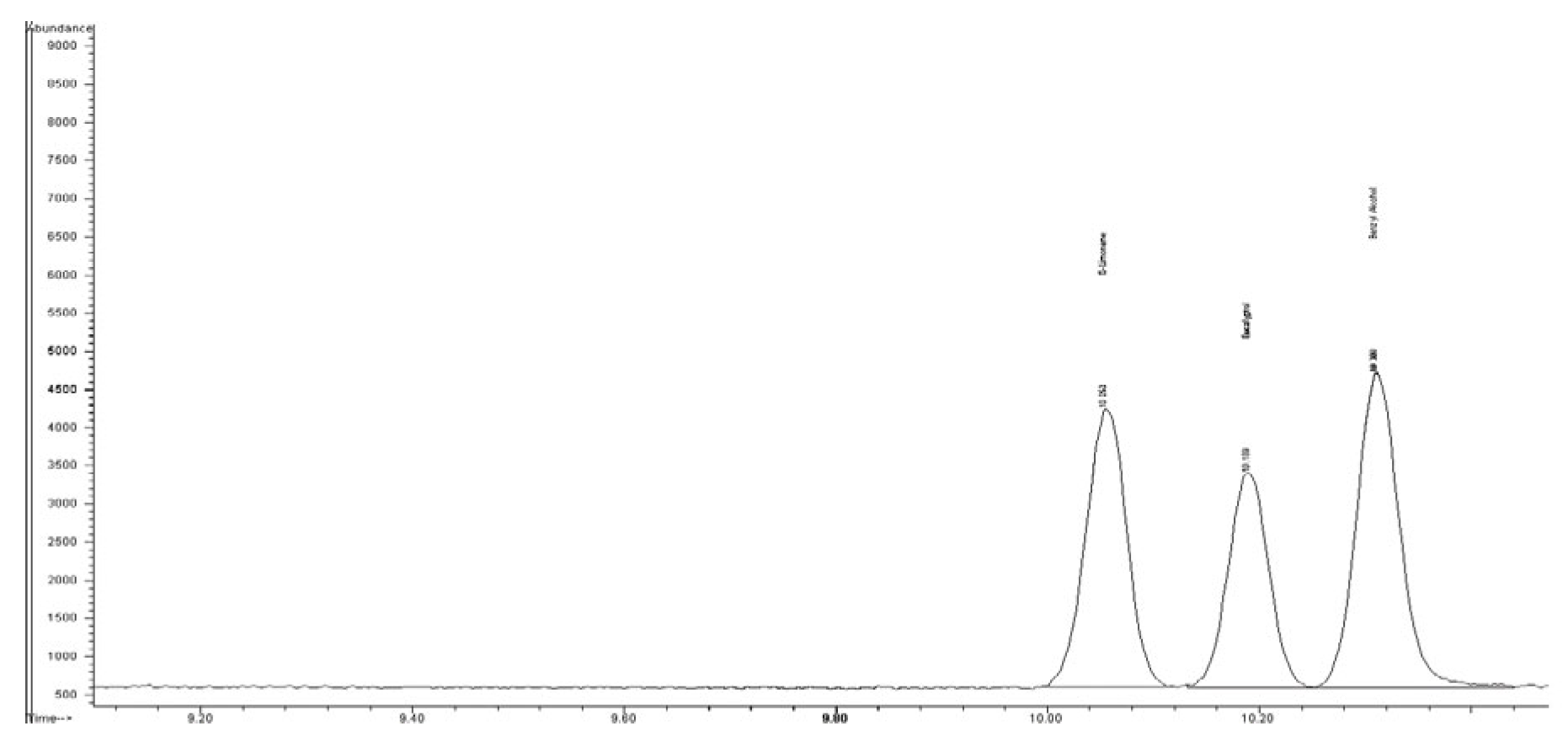

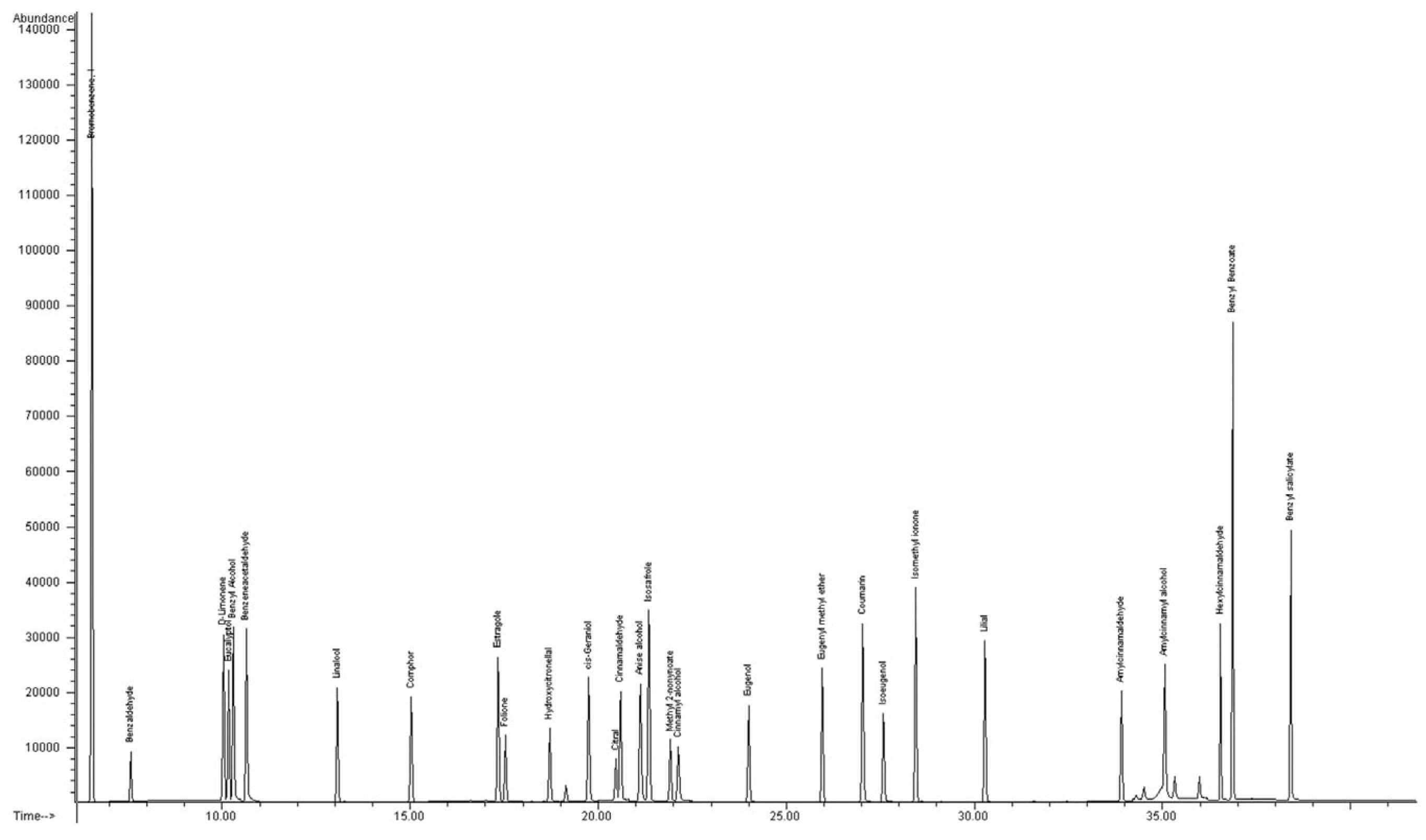
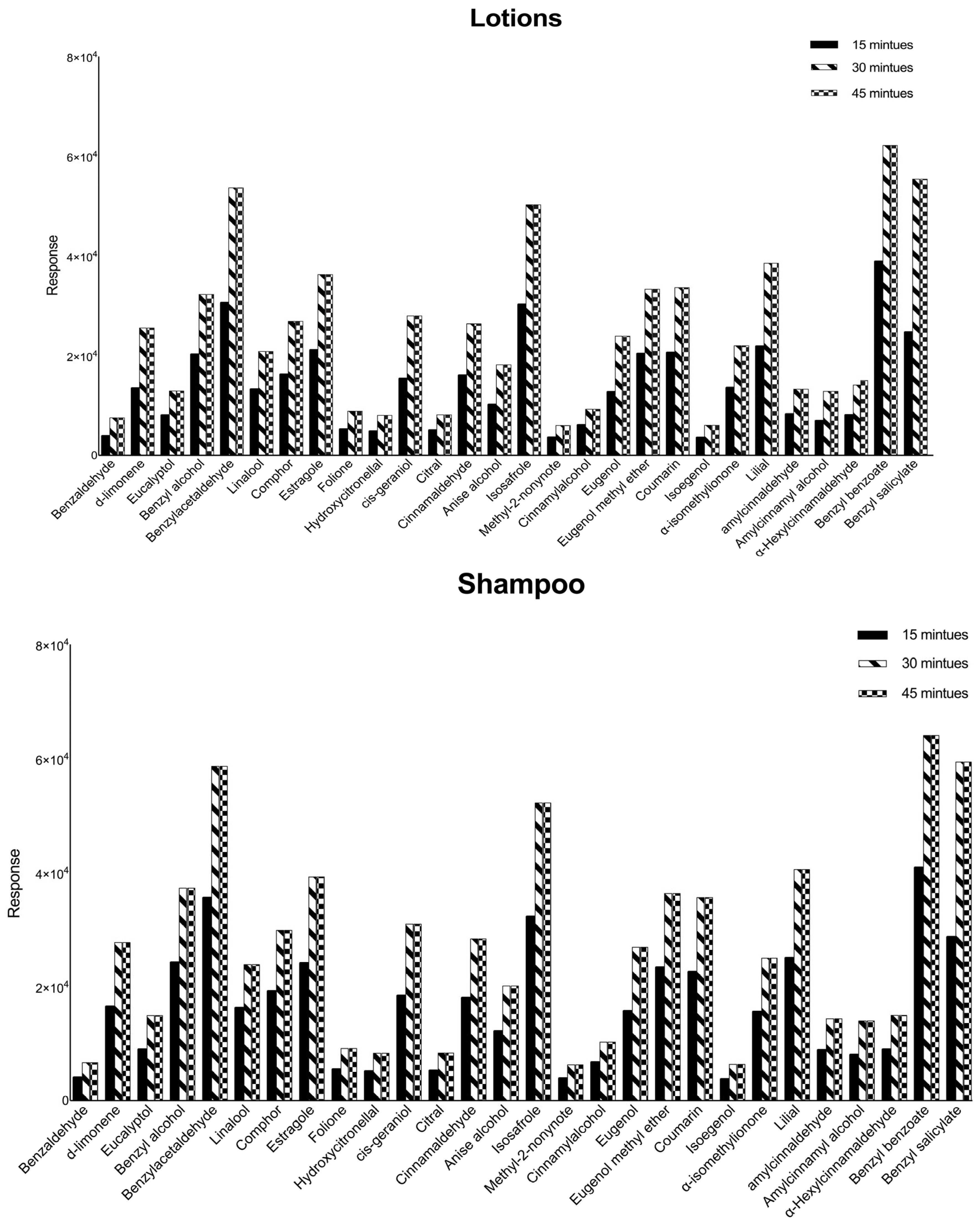
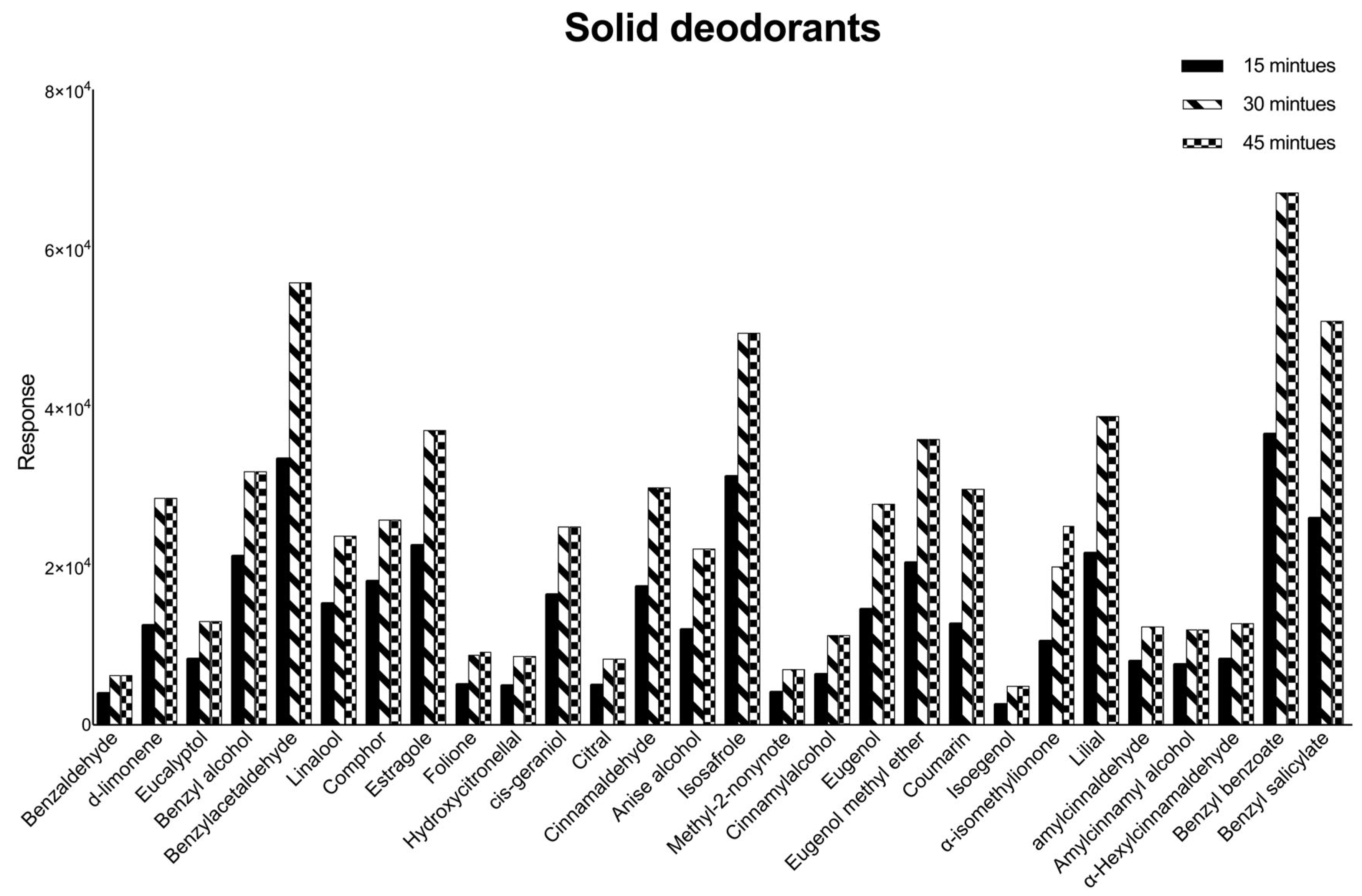
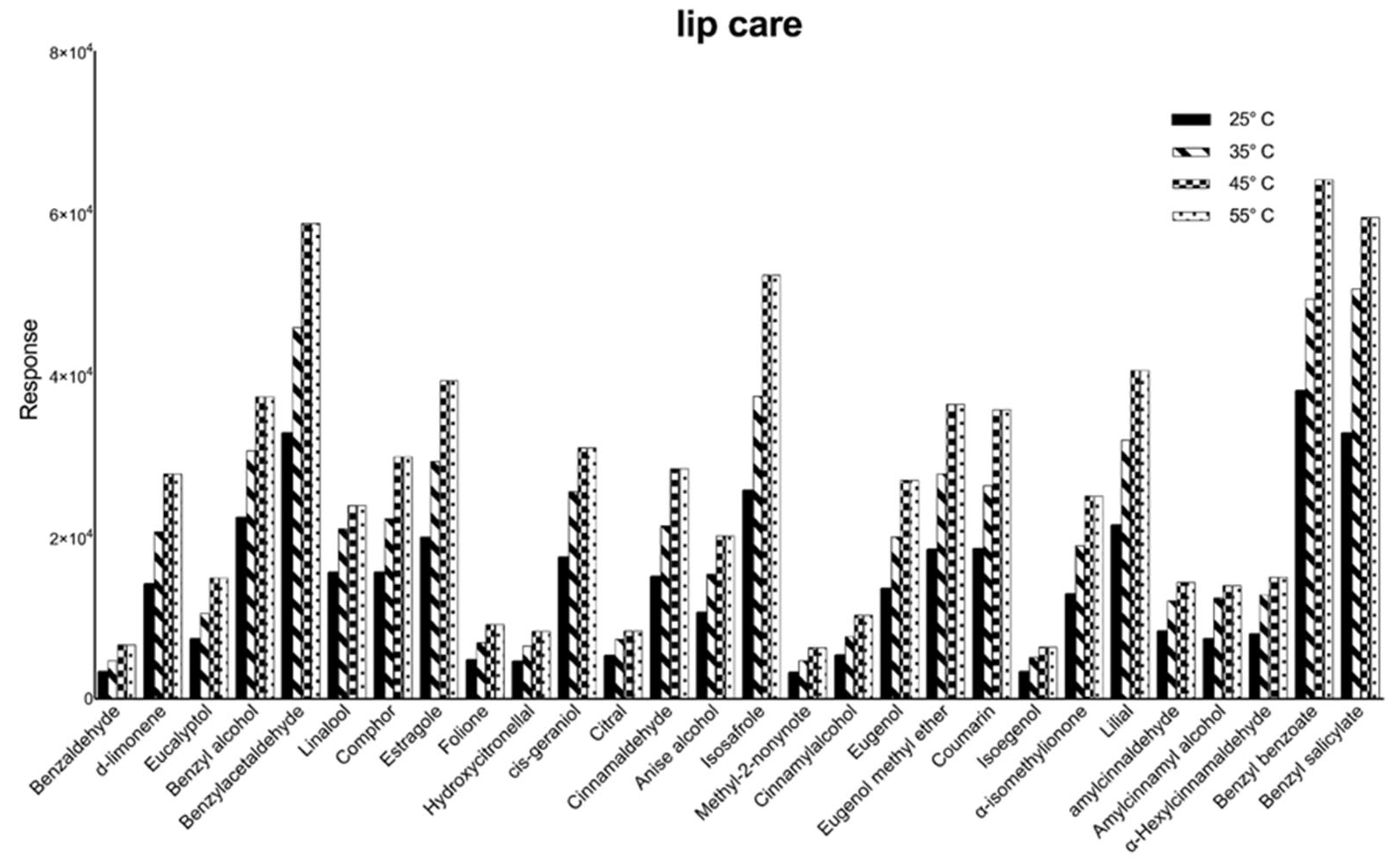
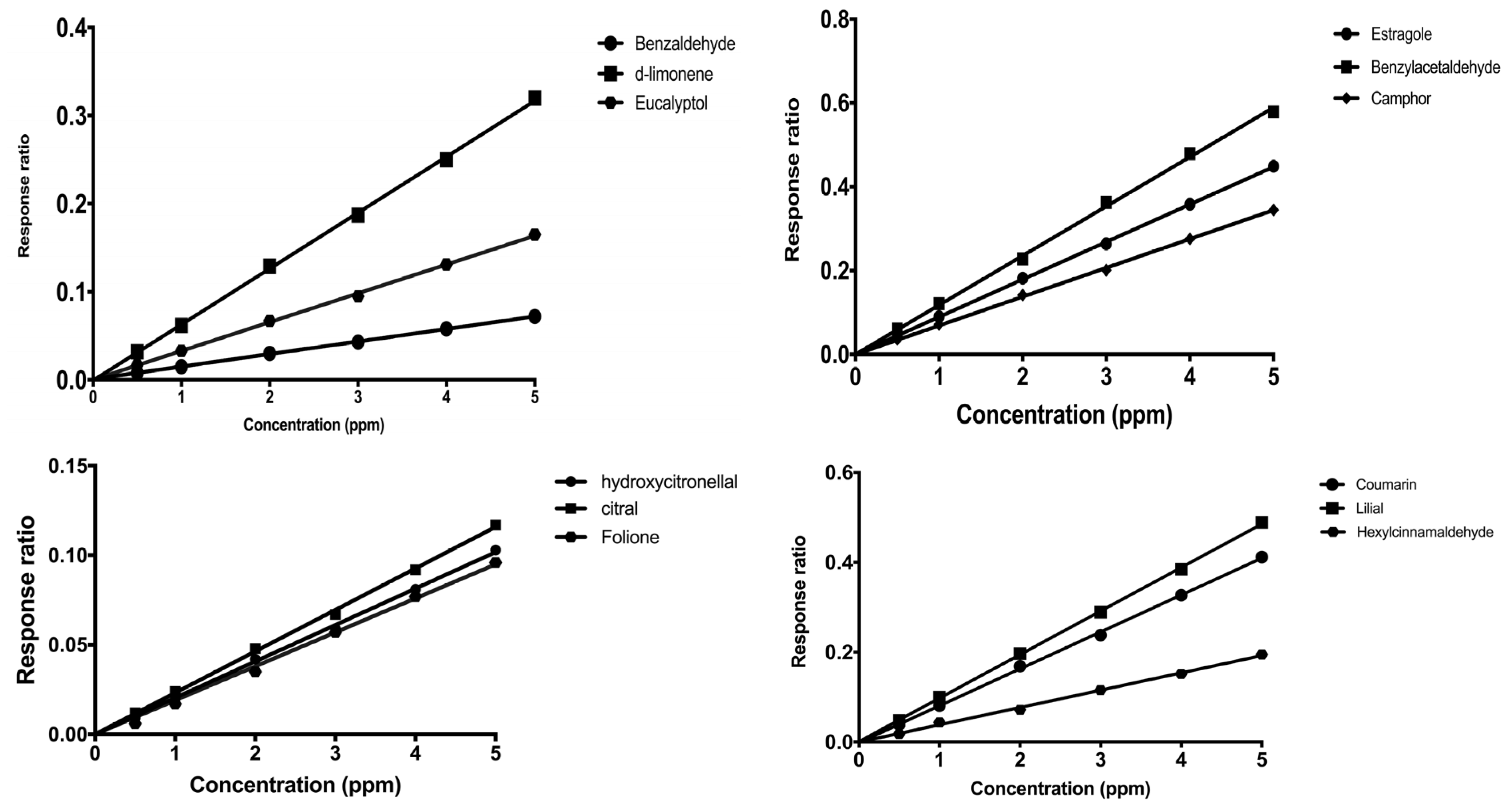
| No | Allergen | CAS Number | Mean RT (min) | Mean RRT (a) | Quantitation Ion (Amu) (b) | Mean (c) r2 | Mean Bias % (d) | Mean RSD% (e) | LOD µg/g (f) | LOQ µg/g (f) |
|---|---|---|---|---|---|---|---|---|---|---|
| 1 | Benzaldehyde | 100-52-7 | 7.59 ± 0.02 | 1.16 | 105 | 0.998 | 3 | 4 | 0.10 ± 0.01 | 0.20 ± 0.03 |
| 2 | d-limonene | 5989-27-5 | 10.05 ± 0.03 | 1.53 | 68 | 0.999 | 4 | 3 | 0.10 ± 0.02 | 0.30 ± 0.06 |
| 3 | Eucalyptol | 470-82-6 | 10.18 ± 0.02 | 1.55 | 81 | 0.997 | 4 | 2 | 0.10 ± 0.01 | 0.30 ± 0.04 |
| 4 | Benzyl alcohol | 100-51-6 | 10.31 ± 0.06 | 1.57 | 79 | 0.997 | 2 | 4 | 0.10 ± 0.02 | 0.30 ± 0.06 |
| 5 | Benzyl acetaldehyde | 122-78-1 | 10.65 ± 0.01 | 1.63 | 91 | 0.998 | 3 | 4 | 0.10 ± 0.01 | 0.30 ± 0.04 |
| 6 | Linalool | 78-70-6 | 13.07 ± 0.01 | 1.99 | 71 | 0.999 | 3 | 3 | 0.10 ± 0.01 | 0.40 ± 0.08 |
| 7 | Camphor | 76-22-2 | 15.03 ± 0.01 | 2.29 | 95 | 0.996 | 2 | 4 | 0.10 ± 0.01 | 0.40 ± 0.08 |
| 8 | Estragole | 140-67-0 | 17.34 ± 0.01 | 2.65 | 148 | 0.997 | 5 | 3 | 0.10 ± 0.01 | 0.20 ± 0.03 |
| 9 | Folione | 111-12-6 | 17.54 ± 0.01 | 2.68 | 123 | 0.999 | 5 | 4 | 0.10 ± 0.01 | 0.20 ± 0.03 |
| 10 | Hydroxycitronellal | 107-75-5 | 18.71 ± 0.02 | 2.86 | 95 | 0.999 | 4 | 4 | 0.10 ± 0.01 | 0.20 ± 0.02 |
| 11 | cis-geraniol | 106-24-1 | 19.74 ± 0.02 | 3.01 | 69 | 0.996 | 5 | 3 | 0.10 ± 0.02 | 0.30 ± 0.06 |
| 12 | Citral | 5392-40-5 | 20.47 ± 0.02 | 3.12 | 69 | 0.998 | 4 | 4 | 0.10 ± 0.01 | 0.20 ± 0.03 |
| 13 | Cinnamaldehyde | 104-55-2 | 20.59 ± 0.02 | 3.14 | 131 | 0.995 | 4 | 3 | 0.10 ± 0.01 | 0.40 ± 0.08 |
| 14 | Anise alcohol | 105-13-5 | 21.12 ± 0.04 | 3.22 | 109 | 0.999 | 4 | 4 | 0.10 ± 0.02 | 0.20 ± 0.04 |
| 15 | Safrole | 94-59-7 | 21.35 ± 0.01 | 3.26 | 162 | 0.998 | 4 | 4 | 0.10 ± 0.01 | 0.30 ± 0.04 |
| 16 | Methyl-2-nonynote | 111-80-8 | 21.92 ± 0.01 | 3.34 | 137 | 0.998 | 5 | 3 | 0.10 ± 0.01 | 0.20 ± 0.03 |
| 17 | Cinnamyl alcohol | 104-54-1 | 22.13 ± 0.04 | 3.38 | 115 | 0.997 | 4 | 4 | 0.10 ± 0.01 | 0.30 ± 0.04 |
| 18 | Eugenol | 97-53-0 | 24.00 ± 0.02 | 3.66 | 164 | 0.996 | 3 | 3 | 0.10 ± 0.02 | 0.40 ± 0.08 |
| 19 | Eugenol methyl ether | 93-15-2 | 25.96 ± 0.01 | 3.96 | 178 | 0.999 | 5 | 4 | 0.040 ± 0.006 | 0.10 ± 0.01 |
| 20 | Coumarin | 91-64-5 | 27.03 ± 0.02 | 4.12 | 146 | 0.998 | 4 | 5 | 0.10 ± 0.01 | 0.30 ± 0.04 |
| 21 | Isoeugenol | 97-54-1 | 27.58 ± 0.01 | 4.21 | 103 | 0.999 | 5 | 4 | 0.10 ± 0.02 | 0.30 ± 0.06 |
| 22 | Alpha-isomethyl ionone | 127-51-5 | 28.44 ± 0.01 | 4.34 | 150 | 0.999 | 2 | 5 | 0.10 ± 0.01 | 0.20 ± 0.03 |
| 23 | Lilial | 80-54-6 | 30.28 ± 0.01 | 4.62 | 189 | 0.997 | 4 | 4 | 0.10 ± 0.02 | 0.30 ± 0.06 |
| 24 | Amyl cinnamaldehyde | 122-40-7 | 33.91 ± 0.01 | 5.17 | 115 | 0.995 | 3 | 3 | 0.10 ± 0.01 | 0.40 ± 0.04 |
| 25 | Amyl cinnamyl alcohol | 101-85-9 | 35.06 ± 0.02 | 5.35 | 115 | 0.999 | 3 | 3 | 0.10 ± 0.02 | 0.20 ± 0.04 |
| 26 | Alpha Hexylcinnamaldehyde | 101-86-0 | 36.54 ± 0.01 | 5.58 | 117 | 0.997 | 3 | 4 | 0.10 ± 0.02 | 0.40 ± 0.08 |
| 27 | Benzyl benzoate | 120-51-4 | 36.86 ± 0.01 | 5.62 | 105 | 0.998 | 5 | 5 | 0.10 ± 0.02 | 0.40 ± 0.08 |
| 28 | Benzyl salicylate | 118-58-1 | 38.41 ± 0.01 | 5.86 | 91 | 0.998 | 5 | 5 | 0.10 ± 0.01 | 0.40 ± 0.08 |
| No | Allergen | Mean r2 | F obs.(a) | F crit.(b) | T obs.(c) | T’ obs. (d) | T crit. (e) |
|---|---|---|---|---|---|---|---|
| 1 | Benzaldehyde | 0.998 | 0.20 | 3.26 | 0 | 0.00 | 8.610 |
| 2 | d-limonene | 0.999 | 0.07 | 2.4 × 10−16 | 0.00 | ||
| 3 | Eucalyptol | 0.997 | 0.11 | 0 | 0.00 | ||
| 4 | Benzyl alcohol | 0.997 | 0.06 | 0 | 0.00 | ||
| 5 | Benzyl acetaldehyde | 0.998 | 0.23 | 7.8 × 10−16 | 0.00 | ||
| 6 | Linalool | 0.999 | 0.38 | 2.1 × 10−16 | 0.00 | ||
| 7 | Camphor | 0.996 | 0.32 | 1.4 × 10−16 | 0.00 | ||
| 8 | Estragole | 0.997 | 0.18 | 2.5 × 10−16 | 0.00 | ||
| 9 | Folione | 0.999 | 0.20 | 3.5 × 10−16 | 0.00 | ||
| 10 | Hydroxycitronellal | 0.999 | 0.32 | 4.5 × 10−16 | 0.00 | ||
| 11 | cis-geraniol | 0.996 | 0.25 | 0 | 0.00 | ||
| 12 | Citral | 0.998 | 1.29 | 0 | 0.00 | ||
| 13 | Cinnamaldehyde | 0.995 | 0.31 | 0 | 0.00 | ||
| 14 | Anise alcohol | 0.999 | 2.0 | 4.4 × 10−16 | 0.00 | ||
| 15 | Safrole | 0.998 | 0.44 | 3.5 × 10−16 | 0.00 | ||
| 16 | Methyl-2-nonynote | 0.998 | 1.21 | 0 | 0.00 | ||
| 17 | Cinnamyl alcohol | 0.997 | 0.66 | 0 | 0.00 | ||
| 18 | Eugenol | 0.996 | 0.77 | 0 | 0.00 | ||
| 19 | Eugenol methyl ether | 0.999 | 0.42 | 0 | 0.00 | ||
| 20 | Coumarin | 0.998 | 0.14 | 0 | 0.00 | ||
| 21 | Isoeugenol | 0.999 | 1.20 | 3.2 × 10−16 | 0.00 | ||
| 22 | Alpha-isomethyl ionone | 0.999 | 0.85 | 0 | 0.00 | ||
| 23 | Lilial | 0.997 | 0.28 | 0 | 0.00 | ||
| 24 | Amyl cinnamaldehyde | 0.995 | 0.54 | 1.3 × 10−16 | 0.00 | ||
| 25 | Amyl cinnamyl alcohol | 0.999 | 0.19 | 0 | 0.00 | ||
| 26 | Alpha Hexylcinnamaldehyde | 0.997 | 0.02 | 2.5 × 10−16 | 0.00 | ||
| 27 | Benzyl benzoate | 0.998 | 1.30 | 2.5 × 10−16 | 0.00 | ||
| 28 | Benzyl salicylate | 0.998 | 0.17 | 7.5 × 10−17 | 0.00 |
| No | Allergen | Mean Q Value (Methanol) | Mean Q Value (Lotion) | Mean Q Value (Perfumes) | Mean Q Value (Aftershave) | Mean Q Value (Shampoo) | Mean Q Value (Deodorant) | Mean Q Value (Wet Wipes) | Mean Q Value (Lip Care) |
|---|---|---|---|---|---|---|---|---|---|
| 1 | Benzaldehyde | 98 | 95 | 94 | 94 | 93 | 95 | 96 | 92 |
| 2 | d-limonene | 100 | 97 | 99 | 95 | 96 | 96 | 97 | 95 |
| 3 | Eucalyptol | 98 | 96 | 95 | 96 | 95 | 97 | 97 | 94 |
| 4 | Benzyl alcohol | 99 | 95 | 97 | 92 | 94 | 96 | 94 | 95 |
| 5 | Benzyl acetaldehyde | 100 | 94 | 96 | 93 | 96 | 95 | 96 | 94 |
| 6 | Linalool | 100 | 96 | 97 | 94 | 95 | 96 | 94 | 93 |
| 7 | Camphor | 99 | 95 | 98 | 91 | 95 | 95 | 96 | 92 |
| 8 | Estragole | 99 | 94 | 97 | 95 | 94 | 95 | 96 | 93 |
| 9 | Folione | 98 | 94 | 96 | 96 | 92 | 94 | 95 | 91 |
| 10 | Hydroxycitronellal | 96 | 93 | 96 | 97 | 91 | 94 | 93 | 90 |
| 11 | Cis-geraniol | 97 | 93 | 97 | 93 | 92 | 94 | 96 | 93 |
| 12 | Citral | 99 | 92 | 97 | 96 | 91 | 95 | 96 | 93 |
| 13 | Cinnamaldehyde | 98 | 96 | 95 | 94 | 93 | 93 | 92 | 91 |
| 14 | Anise alcohol | 97 | 96 | 96 | 92 | 92 | 94 | 92 | 90 |
| 15 | Safrole | 99 | 97 | 98 | 94 | 92 | 96 | 95 | 90 |
| 16 | Methyl-2-nonynote | 97 | 92 | 95 | 93 | 96 | 90 | 93 | 90 |
| 17 | Cinnamyl alcohol | 99 | 92 | 97 | 96 | 95 | 95 | 94 | 91 |
| 18 | Eugenol | 99 | 94 | 98 | 94 | 94 | 96 | 97 | 92 |
| 19 | Eugenol methyl ether | 100 | 95 | 97 | 92 | 95 | 93 | 94 | 92 |
| 20 | Coumarin | 100 | 96 | 98 | 93 | 96 | 95 | 94 | 92 |
| 21 | Isoeugenol | 100 | 96 | 98 | 94 | 96 | 94 | 93 | 94 |
| 22 | Alpha-isomethyl ionone | 100 | 95 | 98 | 95 | 98 | 96 | 95 | 94 |
| 23 | Lilial | 99 | 95 | 96 | 92 | 93 | 94 | 92 | 95 |
| 24 | Amyl cinnamaldehyde | 97 | 92 | 96 | 95 | 94 | 95 | 96 | 92 |
| 25 | Amyl cinnamyl alcohol | 98 | 91 | 95 | 95 | 94 | 93 | 96 | 93 |
| 26 | Alpha Hexylcinnamaldehyde | 95 | 90 | 94 | 96 | 93 | 92 | 92 | 90 |
| 27 | Benzyl benzoate | 96 | 90 | 96 | 93 | 95 | 93 | 95 | 93 |
| 28 | Benzyl salicylate | 98 | 90 | 97 | 92 | 94 | 93 | 97 | 91 |
| No | Allergen | EU % | Matrix Effect % (Lotion) | Matrix Effect % (Perfumes) | Matrix Effect % (Aftershave) | Matrix Effect % (Shampoo) | Matrix Effect % (Deodorant) | Matrix Effect % (Wet Wipes) | Matrix Effect % (Lip Care) |
|---|---|---|---|---|---|---|---|---|---|
| 1 | Benzaldehyde | 15 | 8.0 | 6.0 | 3.0 | 8.0 | 10.0 | 4.0 | 3.0 |
| 2 | d-limonene | 20 | 2.0 | 8.0 | 10.0 | 10.0 | 8.0 | 3.0 | 5.0 |
| 3 | Eucalyptol | 15 | 2.0 | 2.0 | 12.0 | 5.0 | 10.0 | 2.0 | 5.0 |
| 4 | Benzyl alcohol | 20 | 1.0 | 4.0 | 10.0 | 7.0 | 14.0 | 8.0 | 5.0 |
| 5 | Benzyl acetaldehyde | 15 | 1.0 | 4.0 | 8.0 | 8.0 | 10.0 | 5.0 | 6.0 |
| 6 | Linalool | 15 | 1.0 | 5.0 | 1.0 | 1.0 | 8.0 | 9.0 | 3.0 |
| 7 | Camphor | 15 | 1.0 | 5.0 | 1.0 | 1.0 | 7.0 | 3.0 | 2.0 |
| 8 | Estragole | 15 | 3.0 | 4.0 | 12.0 | 10.0 | 15.0 | 10.0 | 8.0 |
| 9 | Folione | 15 | 2.0 | 4.0 | 4.0 | 4.0 | 15.0 | 6.0 | 5.0 |
| 10 | Hydroxycitronellal | 10 | 6.0 | 2.0 | 12.0 | 9.0 | 11.0 | 9.0 | 7.0 |
| 11 | Cis-geraniol | 20 | 6.0 | 7.0 | 14.0 | 10.0 | 8.0 | 10.0 | 6.0 |
| 12 | Citral | 15 | 10.0 | 8.0 | 15.0 | 10.0 | 14.0 | 5.0 | 4.0 |
| 13 | Cinnamaldehyde | 15 | 6.0 | 4.0 | 13.0 | 10.0 | 4.0 | 11.0 | 5.0 |
| 14 | Anise alcohol | 20 | 1.0 | 14.0 | 10.0 | 1.0 | 11.0 | 5.0 | 5.0 |
| 15 | Safrole | 15 | 1.0 | 4.0 | 8.0 | 2.0 | 8.0 | 5.0 | 2.0 |
| 16 | Methyl-2-nonynote | 15 | 5.0 | 4.0 | 4.0 | 4.0 | 15.0 | 6.0 | 1.0 |
| 17 | Cinnamyl alcohol | 15 | 4.0 | 5.0 | 3.0 | 6.0 | 12.0 | 2.0 | 3.0 |
| 18 | Eugenol | 20 | 0.2 | 7.0 | 6.0 | 2.0 | 1.0 | 3.0 | 2.0 |
| 19 | Eugenol methyl ether | 15 | 6.0 | 7.0 | 10.0 | 8.0 | 6.0 | 4.0 | 6.0 |
| 20 | Coumarin | 15 | 3.0 | 5.0 | 15.0 | 14.0 | 12.0 | 7.0 | 8.0 |
| 21 | Isoeugenol | 20 | 1.0 | 10.0 | 12.0 | 10.0 | 16.0 | 8.0 | 10.0 |
| 22 | Alpha-isomethyl ionone | 15 | 3.0 | 15.0 | 2.0 | 2.0 | 5.0 | 6.0 | 2.0 |
| 23 | Lilial | 20 | 0.2 | 0.1 | 0.1 | 0.1 | 0.1 | 0.1 | 0.1 |
| 24 | Amyl cinnamaldehyde | 10 | 4.0 | 9.0 | 11.0 | 4.0 | 10.0 | 1.0 | 4.0 |
| 25 | Amyl cinnamyl alcohol | 20 | 7.0 | 10.0 | 14.0 | 10.0 | 14.0 | 8.0 | 5.0 |
| 26 | Alpha Hexylcinnamaldehyde | 20 | 0.2 | 8.0 | 8.0 | 7.0 | 6.0 | 15.0 | 10.0 |
| 27 | Benzyl benzoate | 20 | 2.0 | 12.0 | 12.0 | 11.0 | 14.0 | 6.0 | 8.0 |
| 28 | Benzyl salicylate | 15 | 6.0 | 8.0 | 8.0 | 12.0 | 1.0 | 7.0 | 2.0 |
| Allergen | Perfumes n 20 | Baby Wet Wipes n 20 | Aftershave n 20 | |||
|---|---|---|---|---|---|---|
| Mean µg/mL | Range µg/mL | Mean µg/mL | Range µg/mL | Mean µg/mL | Range µg/mL | |
| d-limonene | 2204.8 | 1045–4630 | 1.3 | 1.28–1.85 | 524.5 | 134–1772 |
| Benzyl alcohol | <LOQ | <LOQ | 3.7 | <LOQ–21.93 | 336.2 | <LOQ–3069 |
| Linalool | 3691.4 | 383–14,464 | 1.1 | <LOQ–4.83 | 1269.1 | 180–3733 |
| Hydroxycitronellal | 507.5 | <LOQ–4442 | 28.9 | <LOQ–567.13 | 34.65 | <LOQ–258 |
| Cis-geraniol | 533.3 | <LOQ–5447 | 3.7 | <LOQ–36.26 | 340.6 | <LOQ–1859 |
| Citral | 226.2 | <LOQ–750 | 2.4 | <LOQ–6.1 | 26.1 | <LOQ–207 |
| Cinnamaldehyde | <LOQ | <LOQ | <LOQ | <LOQ | 9.65 | <LOQ–193 |
| Anise alcohol | <LOQ | <LOQ | <LOQ | <LOQ | 31.7 | <LOQ–331 |
| Cinnamyl alcohol | 184.1 | <LOQ–524.1 | 1.7 | <LOQ–3.10 | 76.8 | <LOQ–192.1 |
| Eugenol | 157.7 | <LOQ–730.1 | 2.0 | <LOQ–3.43 | 247.6 | <LOQ–2831.1 |
| Eugenol methyl ether | 39.8 | <LOQ–303 | 0.1 | <LOQ–2.39 | 57.3 | <LOQ–262 |
| Coumarin | 752.8 | <LOQ–2324 | 0.6 | <LOQ–2.41 | 172.5 | <LOQ–1022 |
| Isoeugenol | <LOQ | <LOQ | 1.9 | <LOQ–2.25 | 31.7 | <LOQ–223 |
| Alpha-isomethyl ionone | 669.6 | <LOQ–6114 | 2.7 | <LOQ–32.20 | 202.4 | <LOQ–499 |
| Lilial | 2923.2 | <LOQ–17391 | 1.3 | <LOQ–3.25 | 409.45 | <LOQ–3273 |
| Amyl cinnamaldehyde | 170.9 | <LOQ–1630 | <LOQ | <LOQ | <LOQ | <LOQ |
| Amyl cinnamyl alcohol | 184.1 | <LOQ–1631 | 0.5 | <LOQ–3.50 | 167.9 | <LOQ–1425 |
| Alpha Hexylcinnamaldehyde | 368.3 | <LOQ–4040 | 1.9 | <LOQ–18.93 | 1072.4 | <LOQ–5386 |
| Benzyl benzoate | 459.5 | 188–2538 | 0.5 | <LOQ–2.86 | 181.4 | <LOQ–360 |
| Benzyl salicylate | 4722.2 | <LOQ–27280 | 0.63 | <LOQ–4.11 | 370.2 | <LOQ–4115 |
| Allergen | Deodorants n 20 | Shampoo n 20 | Lotion n 20 | Lip Care n 20 | ||||
|---|---|---|---|---|---|---|---|---|
| Mean µg/g | Range µg/g | Mean µg/g | Range µg/g | Mean µg/g | Range µg/g | Mean µg/g | Range µg/g | |
| d-limonene | <LOQ | <LOQ | 60.9 | 12.8–293.4 | 41.7 | <LOQ–148.6 | 263.0 | <LOQ–5621.8 |
| Benzyl alcohol | <LOQ | <LOQ | 0.97 | <LOQ–14.6 | 111.4 | 4.1–1098.5 | <LOQ | <LOQ |
| Linalool | 91.71 | 0.14–109.8 | 63.13 | <LOQ–102.8 | 90.3 | 0.12–315.6 | <LOQ | <LOQ |
| Hydroxycitronellal | 90.19 | <LOQ−1352.36 | 12.50 | <LOQ–138.39 | 1728.65 | <LOQ–9552.9 | 0.24 | <LOQ–1.66 |
| Cis-geraniol | <LOQ | <LOQ | <LOQ | <LOQ | 123.23 | <LOQ–913.26 | 0.05 | <LOQ–0.80 |
| Citral | 274.6 | <LOQ−3769.84 | 24.23 | <LOQ–122.55 | 133.39 | <LOQ–281.1 | 17.67 | <LOQ–512.42 |
| Anise alcohol | 0.30 | <LOQ−4.47 | 0.20 | <LOQ–2.95 | 1.1 | <LOQ–7.72 | 0.90 | <LOQ–16.35 |
| Methyl-2-nonynote | 0.72 | <LOQ−10.82 | <LOQ | <LOQ | <LOQ | <LOQ | 3.37 | <LOQ–34.10 |
| Cinnamyl alcohol | <LOQ | <LOQ | 0.053 | <LOQ–0.50 | 15.3 | <LOQ–192.1 | 0.17 | <LOQ–3.00 |
| Eugenol | 0.026 | <LOQ− 0.17 | 0.014 | <LOQ–0.15 | 5.33 | <LOQ–74.63 | 0.01 | <LOQ–0.22 |
| Eugenol methyl ether | <LOQ | <LOQ | <LOQ | <LOQ | <LOQ | <LOQ | 0.029 | <LOQ–0.36 |
| Coumarin | 1.90 | <LOQ−28.64 | <LOQ | <LOQ | 33.88 | <LOQ–260 | <LOQ | <LOQ |
| Alpha-isomethyl ionone | 50.9 | <LOQ−347 | 0.35 | <LOQ–5.28 | 33.9 | <LOQ–300 | 2.69 | <LOQ–50.0 |
| Lilial | 1269.2 | <LOQ−13067.2 | 247.9 | <LOQ–1356.58 | 135.4 | <LOQ–1417 | 3.93 | <LOQ–52.3 |
| Amyl cinnamaldehyde | <LOQ | <LOQ | <LOQ | <LOQ | <LOQ | <LOQ | 0.18 | <LOQ–1.8 |
| Alpha Hexylcinnamaldehyde | <LOQ | <LOQ | <LOQ | <LOQ | 217.8 | <LOQ -1455 | <LOQ | <LOQ |
| Benzyl benzoate | <LOQ | <LOQ | 1.14 | <LOQ–17.11 | 571.6 | <LOQ–6906.7 | <LOQ | <LOQ |
| Benzyl salicylate | <LOQ | <LOQ | 0.30 | <LOQ–4.05 | 11.21 | <LOQ–123.5 | 14.14 | <LOQ–224.2 |
Disclaimer/Publisher’s Note: The statements, opinions and data contained in all publications are solely those of the individual author(s) and contributor(s) and not of MDPI and/or the editor(s). MDPI and/or the editor(s) disclaim responsibility for any injury to people or property resulting from any ideas, methods, instructions or products referred to in the content. |
© 2023 by the authors. Licensee MDPI, Basel, Switzerland. This article is an open access article distributed under the terms and conditions of the Creative Commons Attribution (CC BY) license (https://creativecommons.org/licenses/by/4.0/).
Share and Cite
AL-Mussallam, A.S.; Bawazir, A.T.; Alshathri, R.S.; Alharthi, O.; Aldawsari, F.S. Optimization of a Gas Chromatography–Mass Spectrometry (GCMS) Method for Detecting 28 Allergens in Various Personal Care Products. Cosmetics 2023, 10, 91. https://doi.org/10.3390/cosmetics10030091
AL-Mussallam AS, Bawazir AT, Alshathri RS, Alharthi O, Aldawsari FS. Optimization of a Gas Chromatography–Mass Spectrometry (GCMS) Method for Detecting 28 Allergens in Various Personal Care Products. Cosmetics. 2023; 10(3):91. https://doi.org/10.3390/cosmetics10030091
Chicago/Turabian StyleAL-Mussallam, Adnan S., Abdullah T. Bawazir, Rawan S. Alshathri, Omniyah Alharthi, and Fahad S. Aldawsari. 2023. "Optimization of a Gas Chromatography–Mass Spectrometry (GCMS) Method for Detecting 28 Allergens in Various Personal Care Products" Cosmetics 10, no. 3: 91. https://doi.org/10.3390/cosmetics10030091
APA StyleAL-Mussallam, A. S., Bawazir, A. T., Alshathri, R. S., Alharthi, O., & Aldawsari, F. S. (2023). Optimization of a Gas Chromatography–Mass Spectrometry (GCMS) Method for Detecting 28 Allergens in Various Personal Care Products. Cosmetics, 10(3), 91. https://doi.org/10.3390/cosmetics10030091






